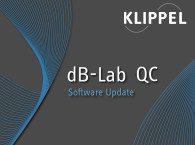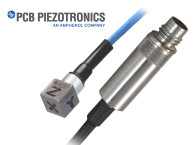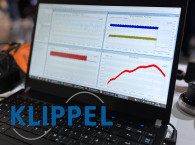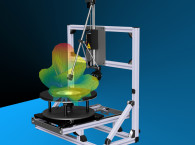
A minor software update is now available for both R&D and QC applications of the Klippel Analyzer System. The update is free of charge for any users of dB-Lab major version 212 or QC 7.
Main features of the update include a major revision of the Multi-Tone Measurement features in the MTON & QC MTD modules. Audio testing using music-like multi-tone signals is a smart approach to rate and evaluate the overall output performance (max. SPL, distortion, compression) of transducers and audio systems in both development and quality control. The two sister modules for R&D (MTON) and EoL testing (QC MTD) have been updated with superior, relative distortion metrics (IEC compliant) for simplified interpretation, comparability and benchmarking.
The MTON Multi-tone Measurement is a Klippel R&D module which provides a complete measurement of the device under test (DUT) using a multi-tone stimulus, and offers different measurement modes to provide a high flexibility of measurement procedures. While the Single Measurement mode performs a single multi-tone measurement, the Multiple Measurements mode offers an automatic test sequence to obtain the operation limits of the DUT related to mechanical and thermal compression as well as multi-tone distortion. This flexibility in the threshold and stimulus configuration allows the MTON module to pinpoint the SPLmax according to IEC 60268-21 [1] as well as the continuous max SPL (ANSI/CEA-2010-B [2] and ANSI/CEA-2034 [3]) among other standard measurements.

Klippel also optimized the half-space measurement applications on the Near Field Scanning Software (NFS) Carousel and Workbench hardware. This makes it even easier to perform asynchronous testing for half-space measurements (e.g., Bluetooth). The Klippel Near-Field-Scanner (NFS) offers a fully automated acoustic measurement of direct sound radiated from the source under test. The radiated sound is determined in any desired distance and angle in the 3D space outside the scanning surface. Directivity, sound power, SPL response and many more key figures are obtained for any kind of loudspeaker and audio system in near field applications (e.g. studio monitors, mobile devices) as well as far field applications (e.g. professional audio systems). Utilizing a minimum of measurement points, a comprehensive data set is generated containing the loudspeaker's high resolution, free field sound radiation in the near and far field.
An updated version of Klippel's Poly2SCN Interface module is now available. The Poly2SCN Interface converts 2D or 3D vibration and geometry data from Polytec scanning systems (Polytec Laser Doppler Vibrometry) to the file format used by the Klippel Scanning Vibrometer System Software, and allows importing large vibrating structures into Klippel SCN software and analyze their acoustic properties. Poly2SCN loads an exported *.unv or *.uff file exported as Transfer function of Displacement, Velocity or Acceleration to Voltage and generates a synthesized grid in which the vibration data is interpolated. The intuitive GUI enables to adjust the position and distribution of the measured points according to the optimized mesh for Klippel Scanner Software.

The Poly2SCN module supports circular, rectangular, asymmetrical or irregular shaped geometries. With the update, users are now able to rate the acoustic performance from external vibration measurements by analyzing the sensitivity at a single point, the sound power response or the directivity characteristics.
Related to this update, Application Note “AN 68 Importing Polytec Datta into SCN” is now available with added information describing the integration of 2D or 3D vibration and geometry data from Polytec scanning systems into Klippel SCN Software files by using the Poly2SCN Interface.
Virtual Lecture 2022
audioXpress and Voice Coil readers will be happy to know that this year Klippel is also promoting a Virtual Lecture event - a condensed format of the annual lecture "Sound Quality of Audio Systems," presented by Prof. Dr. Wolfgang Klippel, usually held at the Technical University in Dresden, Germany. During this online event, attendees will get a deep understanding on the latest measurement and diagnostic techniques used in automotive, telecommunication, multimedia and professional applications, and learn more about the design of small, light and cost-effective loudspeakers.
The Virtual Lecture 2022 event will also promote education and networking opportunities. Regardless of location, users can register and watch the content live or on-demand. The two-day event will be available for a short period of time for all participants. Klippel recommends this event for students, PhD candidates and teachers, as well as product development engineers working in the audio industry. A limited number of registrations is available, so candidates should secure participation and register for the event.
Click here for more information, and clik here for registration.
www.klippel.de







